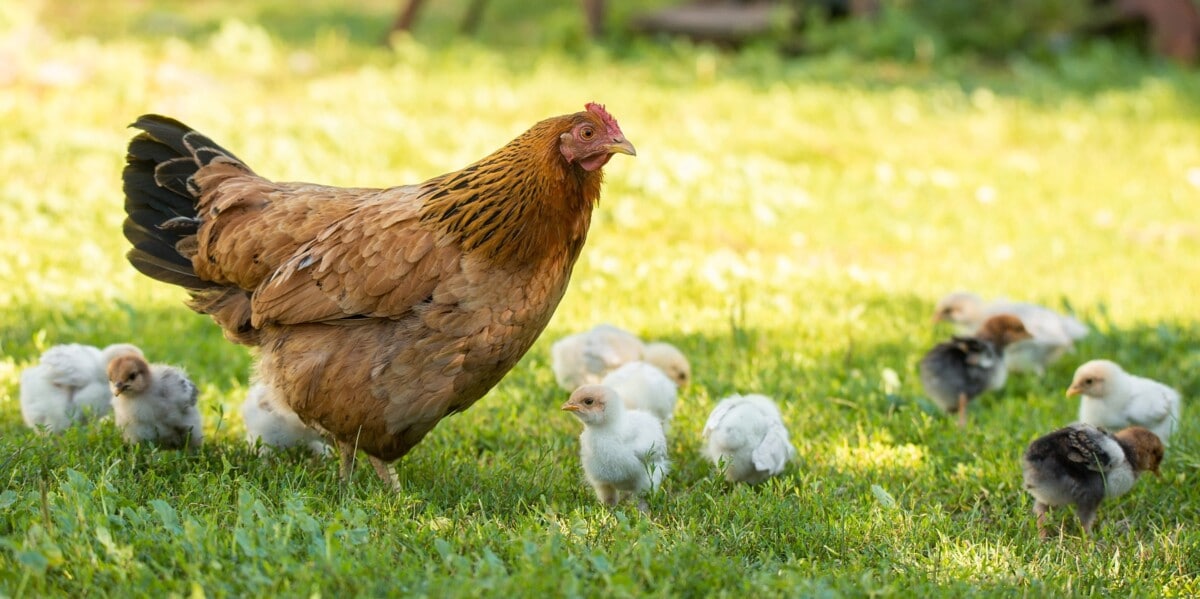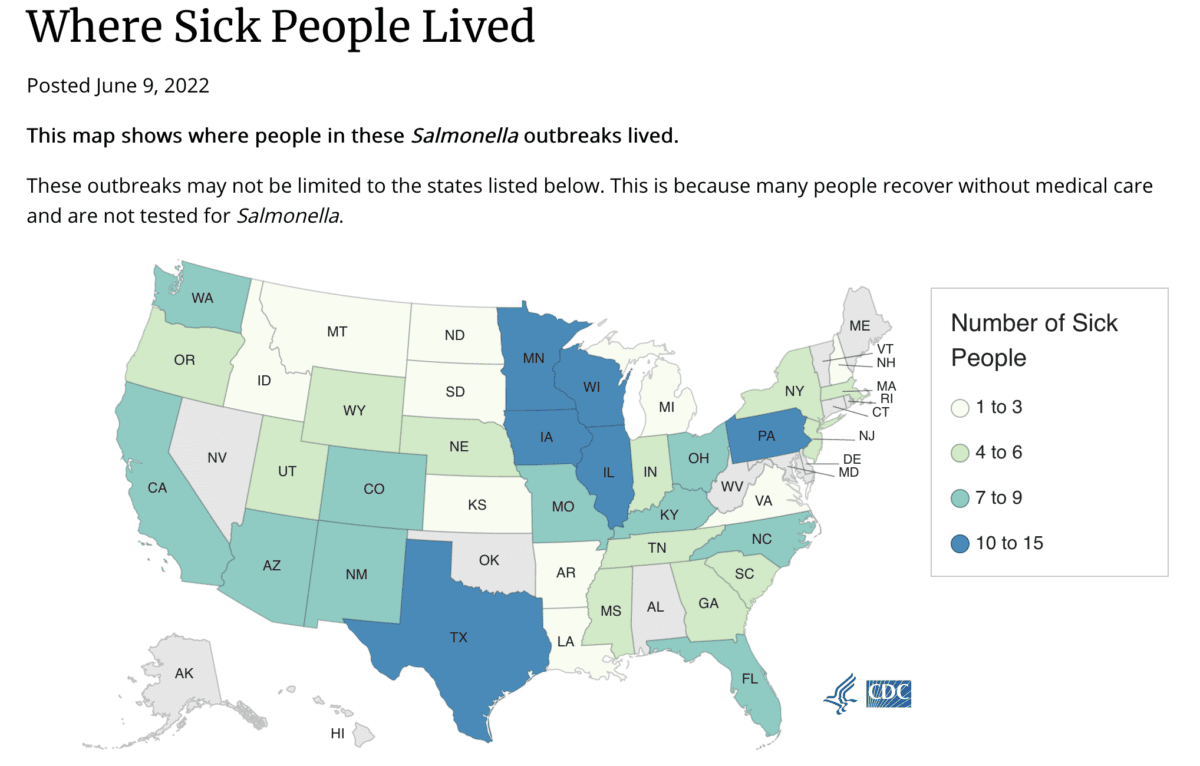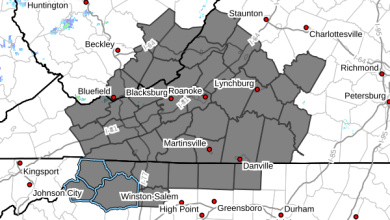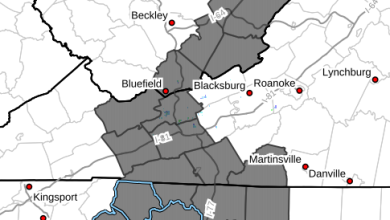
Last Updated on June 11, 2022 7:27 pm
The Centers for Disease Control (CDC) and public health officials in several states are investigating multistate outbreaks of Salmonella infections linked to contact with backyard poultry. The agency stated on Friday that in total, 219 illnesses have been reported from 38 states, and 27 people have been hospitalized. One in four sick people are children younger than 5 years and one death has been reported from Tennessee.
The true number of sick people is likely much higher than the reported number, as many people recover without medical care and are not tested for Salmonella, according the agency. Backyard poultry can carry Salmonella germs even if they look healthy and clean. These germs can easily spread in areas where the poultry live and roam. These outbreaks occur annually and coincide with the increase in baby poultry purchases, beginning in the spring. Last year in 2021, a total of 1,135 people got sick from contact with backyard poultry. These Salmonella outbreaks are not related to recent cases of H5N1 bird flu viruses detected in U.S. wild birds and poultry. However, backyard poultry owners should be aware that the steps needed to stay healthy around their flocks are similar for both diseases.

Backyard Poultry and Salmonella
Backyard poultry, like chickens and ducks, can carry Salmonella germs even if they look healthy and clean. These germs can easily spread to anything in the areas where the poultry live and roam.
You can get sick from touching your backyard poultry or anything in their environment and then touching your mouth or food and swallowing Salmonella germs.
What Backyard Flock Owners Should Do
- Wash your hands
- Always wash your hands with soap and water immediately after touching backyard poultry, their eggs, or anything in the area where they live and roam.
- Use hand sanitizer if soap and water are not readily available. Consider having hand sanitizer at your coop.
- Be safe around backyard flocks
- Don’t kiss or snuggle backyard poultry, and don’t eat or drink around them. This can spread Salmonella germs to your mouth and make you sick.
- Keep your backyard flock and supplies you use to care for them (like feed containers and shoes you wear in the coop) outside of the house. You should also clean the supplies outside the house.
- Supervise kids around flocks
- Always supervise children around backyard poultry and make sure they wash their hands properly afterward.
- Don’t let children younger than 5 years touch chicks, ducklings, or other backyard poultry. Young children are more likely to get sick from germs like Salmonella.
- Handle eggs safely
- Collect eggs often. Eggs that sit in the nest can become dirty or break.
- Throw away cracked eggs. Germs on the shell can more easily enter the egg through a cracked shell.
- Rub off dirt on eggs with fine sandpaper, a brush, or a cloth. Don’t wash eggs because colder water can pull germs into the egg.
- Refrigerate eggs to keep them fresh and slow the growth of germs.
- Cook eggs until both the yolk and white are firm, and cook egg dishes to an internal temperature of 160°F to kill all germs.
Call your healthcare provider right away if you have any of these severe symptoms:
- Diarrhea and a fever higher than 102°F
- Diarrhea for more than 3 days that is not improving
- Bloody diarrhea
- So much vomiting that you cannot keep liquids down
- Signs of dehydration, such as:
- Not peeing much
- Dry mouth and throat
- Feeling dizzy when standing up
What Stores Selling Poultry Should Do
- Source poultry from hatcheries that take steps to reduce Salmonella contamination.
- These hatcheries include those that have adopted the U.S. Department of Agriculture’s (USDA’s) best management practices to mitigate Salmonella contamination [PDF – 25 pages] and those that voluntarily participate in USDA’s National Poultry Improvement Plan (USDA-NPIP) U.S. Salmonella Monitored Program [PDF – 17 pages].
- Clean and sanitize poultry display areas between shipments of new poultry.
- Be sure to remove dirt by cleaning first. Then apply the disinfectant on the surface for the proper contact time recommended on the disinfectant label.
- Help keep your customers healthy.
- Provide handwashing stations or hand sanitizers next to poultry display areas and tell customers to wash hands right after leaving these areas.
- Display poultry out of reach of customers, especially children, so they cannot easily touch the poultry.
- Provide health information to owners and potential buyers of poultry before purchase. This informational poster [PDF – 1 page] describes ways to stay healthy with backyard flocks. Place it right beside flock display areas, and hand it out to customers.
- Learn more about how to protect your customers and employees from Salmonella and other diseases shared between animals and humans.
What Poultry Hatcheries Should Do
- Use best management practices [PDF – 25 pages] to help prevent Salmonella in poultry.
- Participate in the voluntary USDA-NPIP U.S. Salmonella Monitored Program [PDF – 17 pages] and certify that your flocks are monitored for Salmonella germs.
- Provide health information to owners and potential buyers of poultry before purchase. This informational poster [PDF – 1 page] describes ways to stay healthy with backyard flocks. This graphic can be printed as a sticker and placed on poultry shipping boxes.
Symptoms of Salmonella
- Most people infected with Salmonella experience diarrhea, fever, and stomach cramps.
- Symptoms usually start 6 hours to 6 days after swallowing the bacteria.
- Most people recover without treatment after 4 to 7 days.
- Some people—especially children younger than 5 years, adults 65 years and older, and people with weakened immune systems—may experience more severe illnesses that require medical treatment or hospitalization.
- For more information about Salmonella, see the Salmonella Questions and Answers page.
















